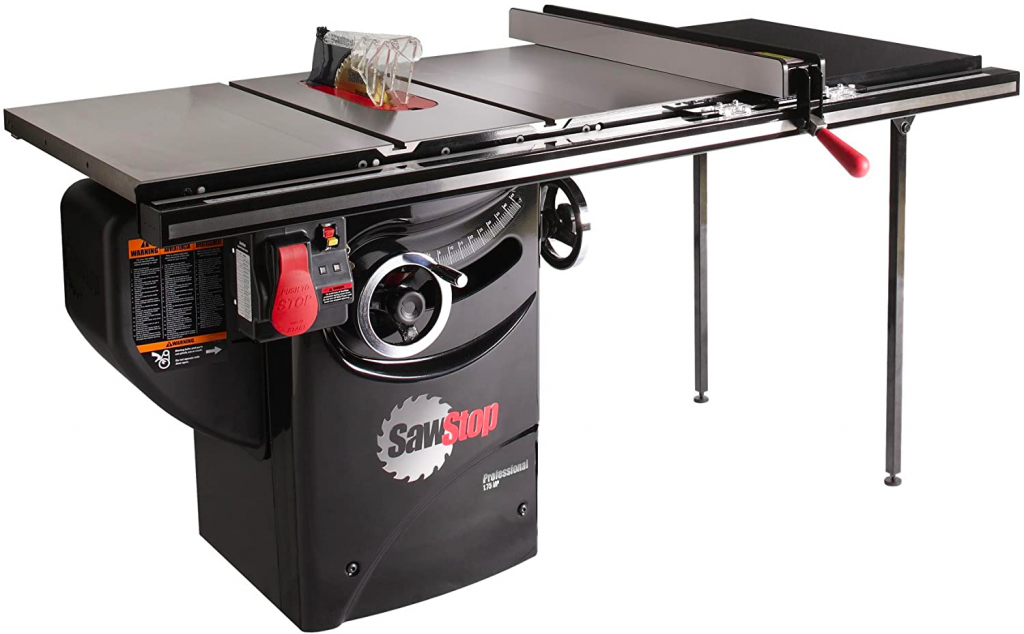
Once seen as a dying art, woodworking is finding new popularity. This is great news. Home workshops are timeless places of calm and fulfillment that also happen to produce wonderful, handcrafted pieces.
One big question in any new carpenter’s mind is how to achieve long, straight rips. It isn’t easy to do this with a beginner toolkit, but it’s essential for many applications. So what’s the answer?
Precision using a hand saw is difficult for obvious reasons: great patience is required to make sure you aren’t deviating from the line. Bandsaws are more effective but often have a small table, and the saw’s body can obstruct wider pieces of wood.
If you need to make long, straight rips through wide boards, this is generally when to use a table saw. There’s no obstruction like a bandsaw, and the broad table makes it easy to guide the wood. It’s not a cure-all, but it does certain jobs better than pretty much any other saw and can make a great addition to your carpentry shop.
Here’s what you need to know about when to use a table saw, how this equipment works, and why you should use it.
Contents
When to Use a Table Saw
Ripping large sheets or planks of wood is required for many carpentry products: tables, chairs, and shelves all require long cuts to trim them to size. Neatness is paramount here (unless you love sanding). A table saw allows you to achieve a very consistent rip because you can easily monitor the cut from your position above the table.
As mentioned, this is a godsend for what it does well but is not a workshop panacea. You have to know when to use a table saw and when not to.
For example, it’s less ideal for fiddly cuts such as curves (a bandsaw is generally better for this) because of the wide circular saw. You can cut curves with a circular blade, but this requires practice.
What are the Types of Table Saw?
There are several styles of a table saw. Each has advantages depending on the kind of carpentry work you do.
Portable
This is the most basic and affordable kind of table saw. There are two wide varieties:
- Benchtop
- Jobsite
Both are typically placed on a table or stand for support, with the major difference being that jobsite models are slightly larger and more powerful.
These are an ideal choice for budding carpenters. They’re affordable and work well for making even cuts in the kind of materials you’d find in a home workshop.
Example: Bosch GTS1031

Bosch is known for producing woodworking kits that rarely break down or develop faults. The Bosch GTS1031 is a trendy portable table saw.
Features include:
- 10″ blade, spins at 5000rpm
- Modular blade guard
- Only weighs 52lbs, easy to transport and great for home use
Contractor
For slightly more heavy-duty rips, you might want to consider a contractor saw. These are larger than portable models but can still run off the power provided by standard home electrical circuits.
These have good application for cutting through thick or dense materials. This is an important distinction, as using a weaker saw for heavy cuts can easily damage the blade or motor.
Example: DEWALT DWE7491RS 10-Inch Table Saw

DEWALT is another superb brand for woodworking. The brand is known for innovation, consistency, and top-quality results. The DWE7491RS is a great example of this and would make a great choice if a contractor saw suits your purposes.
Features include:
- 10-inch blade spinning at 4,800rpm
- 15-amp motor
- Onboard storage system
- Coated table surface reduces friction for smoother cuts
Cabinet
These are far heavier and more powerful and are generally used for industrial applications. Cabinet table saws have an enclosed base (the ‘cabinet’) and are free-standing. This offers far lower vibration, allowing for greater control. Dust collection is also much more efficient because of the enclosed base.
These models are more expensive and also require more power than a typical home circuit can provide. However, they produce excellent results.
Example: SawStop PCS175-TGP236

SawStop is another leading brand, having produced one of the all-time great cabinet table saws. For serious woodworkers, this would make an incredible addition to your workshop.
Features include:
- The motor is 1.75HP but has an option for 3HP, providing amazing power
- 10-inch professional-grade blade
- 30, 36, or 52-inch rip capacity for big jobs
- 4-inch dust port for 99% dust collection
- Minimal vibration
There’s no hiding that this is a costly upgrade. Cabinet models are just like that. If you do want to commit, though, you will notice the difference.
Hybrid
Designed to offer the best of both worlds, hybrid saws incorporate the following features:
- Cabinet for dust collection
- Lighter than cabinet table saws
- Ability to run off household electric circuits
- Heavier than contractor saws for lower vibration
More experienced home carpenters might consider paying a bit extra for a hybrid table saw. They’re generally cheaper than cabinet models and better-adapted for home use.
Example: Shop Fox W1837

Shop Fox has a reputation for durable products that are user-friendly and reliable. The W1837 is no exception to this and is a wonderful example of what hybrids have to offer.
Features include:
- 2HP Leeson induction motor for great cutting power
- 30-inch rig capacity
- 4-inch port dust chute
- Clear guard to see blade movement during cutting for safety
The price difference between this and a cabinet saw is huge, but the cutting power is still there. So is the dust collection and the wide rig capacity. This is a great choice if you’re looking to take your woodworking game to the next level.
Conclusion
Knowing how and when to use a table saw is just as important as choosing all of your woodworking equipment. Over 30,000 table saw accidents occur annually, so you must take care of this machine if you want quality cuts safely.
These tools are incredibly useful and add an extra dimension to your home workshop when used properly. Check out the main options, find what’s right for you, and happy crafting!
